Panhellenic Worship: Delphi and Olympia
1/76
Earn XP
Description and Tags
Name | Mastery | Learn | Test | Matching | Spaced |
|---|
No study sessions yet.
77 Terms
Which 4 games formed the Olympics/periodos, and how often were they held? Which god was worshipped at each sanctuary?
Every 4 years:
Pythian Games @ Delphi: Pythian Apollo
Olympian Games @ Olympia: Olympian Zeus
Every 2 years:
Nemean Games @ Nemea: Nemean Zeus
Isthmian Games @ Isthmus: Isthmian Poseidon
What were the competitions and prizes at each games of the periodos?
All 4 events had athletic and equestrian competitions — however the Pythian and Isthmian games also included musical contests.
Prizes = a wreath of:
Laurel at Delphi
Wild olive at Olympia
Wild celery at Nemea
Pine at Isthmus
What was the title for someone who held victories in all 4 games?
Periodonikes.
Where is Delphi located?
Central Greece — to the ancients it was considered the centre of the world.
Which two myths are linked to the site of Delphi?
Zeus is said to have released two eagles which met at the centre, which was marked by a stone called the omphalos, later stored in the Temple of Apollo.
Delphi originally belonged to Gaea and was guarded by her child Python, a serpent that Apollo slew — hence the epithet Pythian Apollo. He then founded his oracle there.
Explain the history of the Delphi cult of Apollo.
Priests from Kossos brought the cult in the 8th Century BCE
During the first sacred war c. 590 BCE, the Amphictyonic League destroyed the nearby town Krisa, whose taxation of visitors to the oracle prompted the war, so free access to Delphi was opened.
The reorganised Pythian Games were then held every four years from 582 BCE, at which point the prestige of the Delphi oracle was at its height.
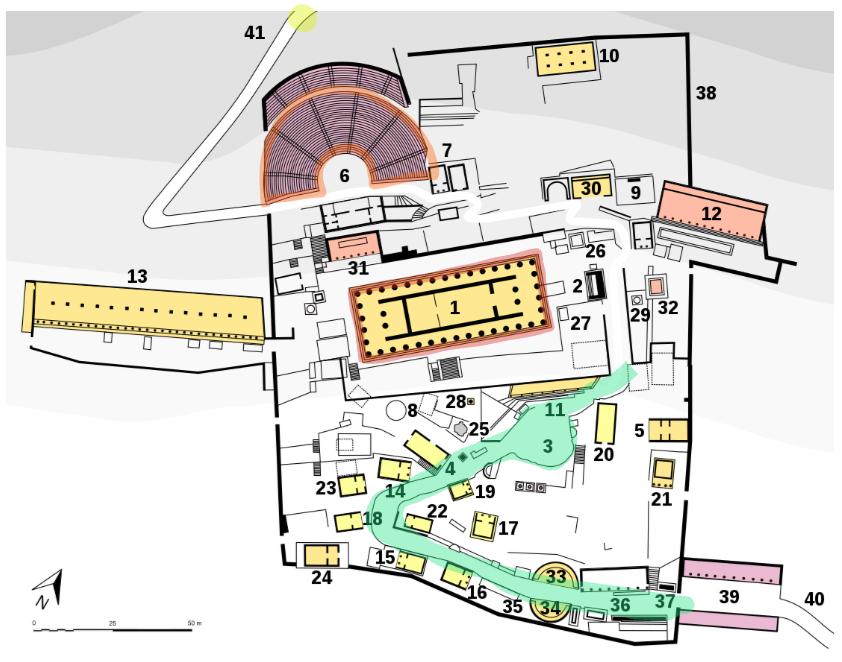
Label the highlighted areas.
Red = Temple of Apollo
Orange = Theatre
Yellow = Stadium
Green = Sacred Way
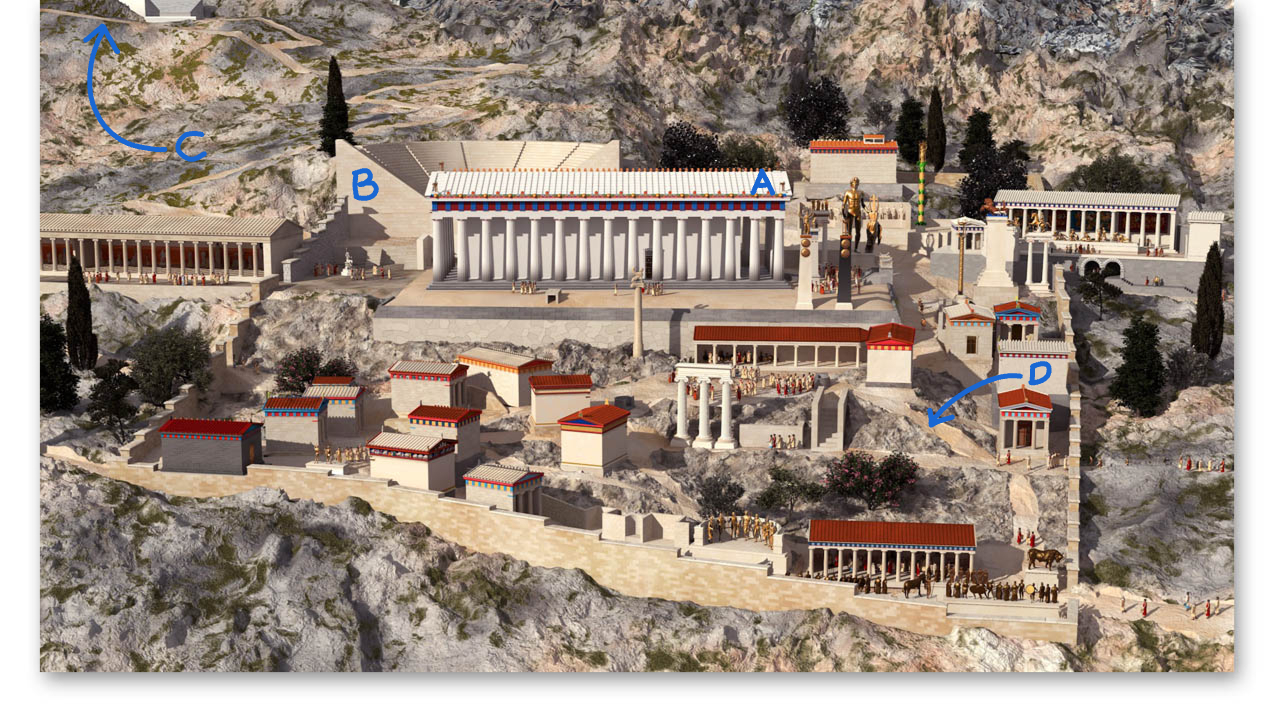
Label the Delphi Sanctuary of Apollo.
A = Temple of Apollo
B = Theatre
C = Stadium
D = Sacred Way
Describe the layout of the Sacred Way.
By the entrance of the path were clusters of life-size sculpture, arranged on raised stone platforms like small theatre stages.
The path took visitors along the whole site in 3 zig-zags that had natural rest areas in the corners via treasury houses, an. The path was on a dramatic, steep incline & was only one-way, giving the site a pilgrimage feel with a climax of the Temple of Apollo.
Describe the sculptures clustered by the entrance of the Sacred Way, with specific examples.
Mainly victory monuments for wars between Greek poleis.
This included the Marathon monument dedicated by Athens, including a dozen impressive bronzes by Pheidias such as Athene, Apollo, Erectheus, Kekrops, and perhaps the Riace Warriors.
Another group commemorated Tegea’s victory over Sparta
Another group commemorated Sparta’s victory over Athens
Describe the purpose of the temples along the Sacred way. How many were there?
They were themselves offerings to the god, but also included offerings
They showcased the cities which offered them, forming a permanent presence for that city in the international centre and meeting-place.
There are at least 30 treasuries whose foundations can still be seen.
Which 2 treasuries at Delphi still have substantial remains?
The Athenian treasury, which displays a famous wall covered with inscriptions e.g. musically annotated hymns to Apollo
The Siphnian Treasury with the displayed frieze including the Trojan War (East) and a Gigantomachy (North)
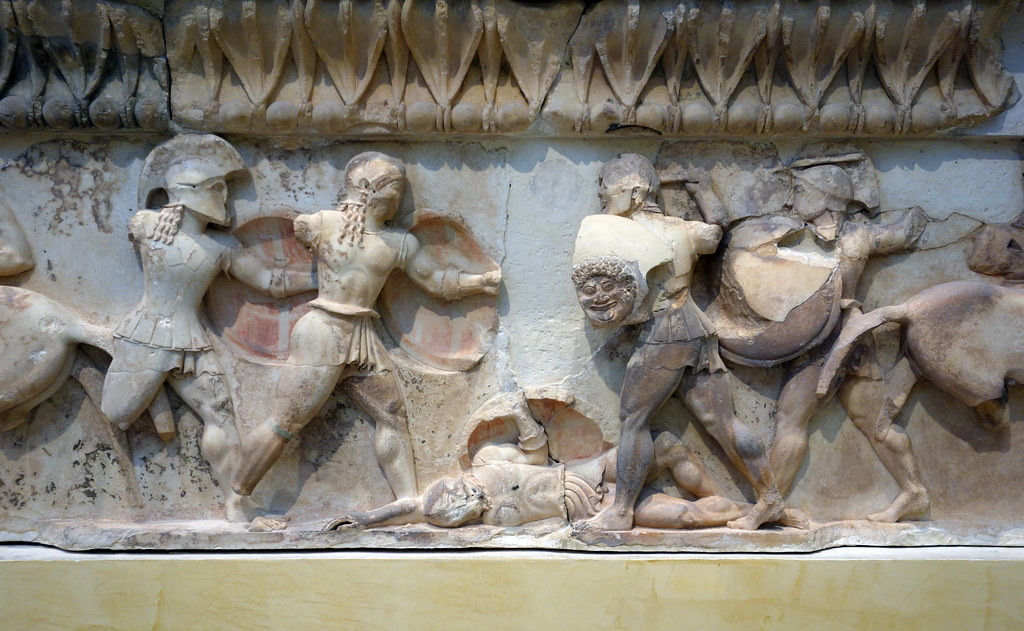
Label the figures from this scene on the East frieze of the Siphnian Treasury.
Memnon (left) and Achilles (right) with a gorgon on his shield. On the ground is Nestor’s son, Antilocus.
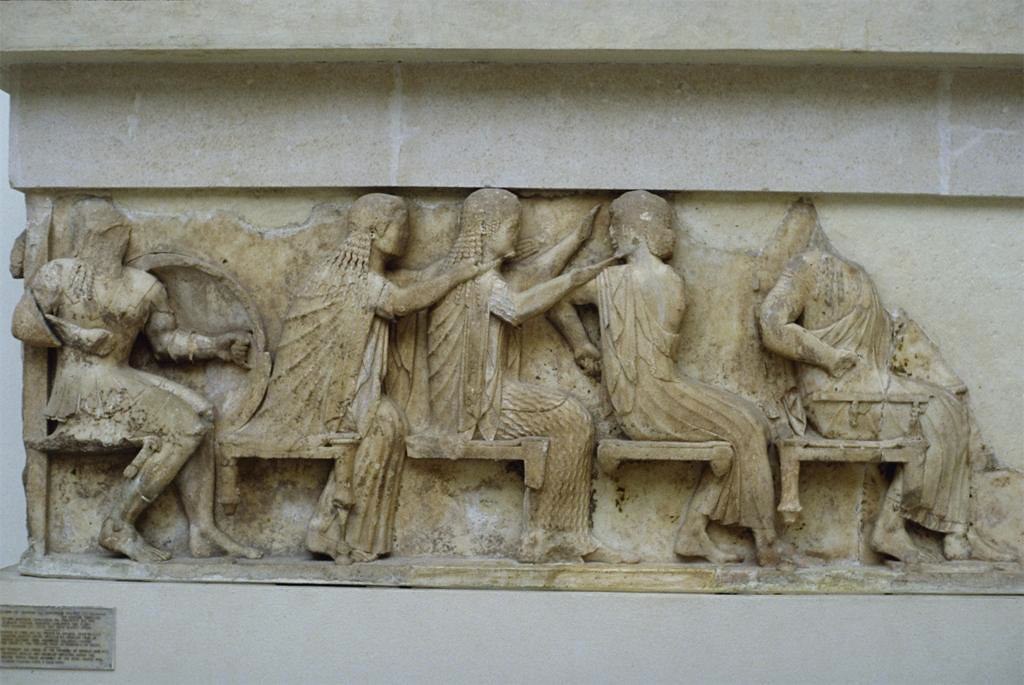
Label the figures from this scene on the East frieze of the Siphnian Treasury.
From left to right: Ares, Eos, Artemis, Apollo, and Zeus. These are all gods associated with Trojans.
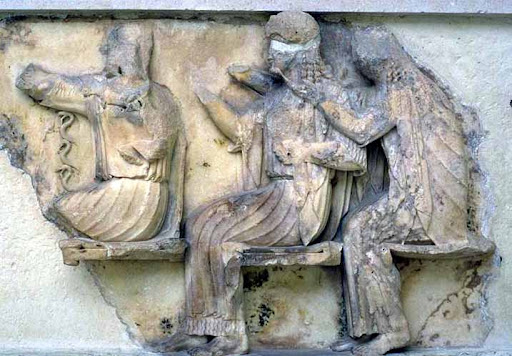
Label the figures from this scene on the East frieze of the Siphnian Treasury.
From left to right: Athena, Hera, Thetis. These are all gods associated with Greeks.
What stood opposite the entrance to the temple of Apollo?
A triple bronze serpent surmounted by a golden victory tripod, commemorating the Plataea versus Persian battle. This was a more upbeat war memorial on which the names of allied Greek cities who fought together inscribed on the serpent’s body.
What happened to the archaic temple of Apollo?
It burnt down in 548 BCE
What date does the ruins from the Temple of Apollo we have today originate from? What makes it unique?
4th Century BCE (built after the landslide of 373 BCE). It preserves the style of the original archaic temple, completed by the Athenian Alcmaeonid family.
What stands at the entrance to the Temple of Apollo?
A small forecourt, on which stands the altar of the Chians made of a large dark limestone rectangular block, with a marble cornice ontop and a similar moulding at its foot. This was a very prestigious offering, which granted its donor polis of the Chians priorit in consulting the oracle.
Translate “Promanteia”.
Priority in consulting the oracle.
What occurred on the forecourt? What is our source?
A temple servant would be tending to the temple, and queues of people waiting to consult the oracle which the servant would be instructing of procedure, checking their credentials, and receiving their offerings. This is reminiscent of the young hero Ion in Euripides’ play, Ion.
How many days a year was the oracle of Delphi open?
9
List the decorations/ornaments within and around the temple. (5)
The omphalos in the cella
A laurel tree
A statue of Apollo
The grave of Dionysus
The 3 Delphic Maxims: “Nothing in excess”, “Know thyself”, and, rather cryptically, a letter “E”.
When and who by was the late Archaic version of the Temple of Apollo made?
Between 530—520 BCE by the Alkmaionids.
What was depicted on the pediments of the late Archaic version of the Temple of Apollo?
East:
The East pediment shows the arrival of Apollo by chariot, with lions in the corner eating animal victims, and two female figures (Artemis and Leto, probably) amongst horses.
West:
The West pediment probably featured a limestone battle between gods and giants.
What was depicted on the pediments of the Classical version of the Temple of Apollo?
East:
The East pediment shows the Apollo on the left, seated on a tripod holding a branch of laurel and a phiale — symbols of his oracle —with Leto and Artemis amongst the muses.
West:
The West pediment featured Dionysus amongst the Thyiads (maenads that especially practised on Mount Parnassus).
Translate “temenos”.
The sacred grounds around a temple.
Describe the seating and capacity of the theatre at Delphi.
The stone seating was completed in the 2nd Century BCE which monumentalised the earlier informal seating arrangement which took advantage of the natural terrain.
There are 35 rows of seats, with a capacity of 5,000 spectators. The first competitions would have been musical — Apollo being the patron of music — and sports added later.
Describe the location, stature, and capacity of the stadium at Delphi.
A break in the peribolos wall led to a steep path through rocks and pine trees, leading to the stadium fitted into a terraced area high above the sanctuary, round a shoulder of the mountain.
This stadium was 177.5 metres in length, and had seating for 6,500 spectators arranged on both sides of the track. There are stone piers marking the starting places for runners and a sign by the entrance instructing visitors not to take wine out of the stadium.
Where were footraces held before the stadium was built?
Before its construction in the 3rd Century BCE, they were held in the valley.
How did the Sacred Way create drama? (5)
Zig-zag & steep incline
Victory monuments clustered at the beginning
Treasuries e.g. Athenian and Siphnian
You had to walk the length of the temple below the terrace and also past the serpentine column before entering the temple
Incline & winding path through rocks and pine trees to reach the huge stadium.
Who was the Pythia? What was she originally called?
The medium by which Apollo’s word was spoken. She would be a woman over fifty who lived apart from her husband and dressed in a maiden’s clothes.
Originally called Pytho.
When did the popularity of the Pythia peak? What for?
Despite being known to Homer and being the site of Mycaenean settlement, popularity didn’t peak until the 7th & 6th Centuries BCE, when she was sought by lawmakers, colonists, and cult founders. The oracle was most consulted for war outcome and political action forecasts e.g. Sparta and Athens visited Delphi before the attack of Xerxes on Greece.
Describe the process of consulting the Pythia.
The pythia and her consultants bathed in the Castalian spring, after which she drank from the Cassotis, and then entered the temple
She then descended into a basement cell, mounted a sacred tripod, and chewed laurel leaves (Apollo’s sacred tree), in order to enter her ecstatic state. Some scholars however believe this occurred due to vapours emanating from the ground, confirmed by geologists due to fault lines in the earth.
Water was sprinkled onto a goat: if it shuddered, Apollo had contented to the consultation.
The pythia would speak, which would be interpreted and written down by the priests for the enquirer, in often highly ambiguous verse.
When were consultations restricted to?
The 7th day of the Delphic month (Apollo’s birthday). In the beginning consultation was also banned during the three winter months when Apollo was believed to be visiting the Hyperboreans in the North, though Dionysus later filled in.
What was the alternative oracle to the Pythia at Delphi?
The nearby Corycian cave where yes/no questions were posed & a black and white dice informed the answer.
Explain the payment system of the oracle at Delphi.
Sponsors were necessary as well as providing a pelanos (ritual cake) and a sacrificial beast that conformed to rigid physical standards
The payment amount differed for state versus private consultants, as well as by poleis e.g. Athens paid more as it was a wealthy polis
Certain individuals e.g. King Croseus did not have to pay at all
What were the most common questions to ask the Pythia? (+ source)
Plutarch says they were:
If they will be victorious
If they will marry
If it is profitable to sail
If to farm
If to travel
This mirrors the lead tablets at Dodona
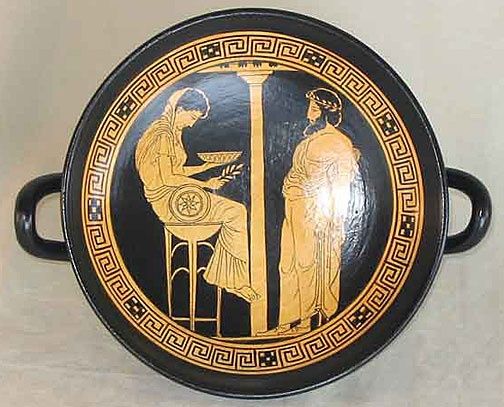
The Pythia at Delphi Kylix: Date, location, attribution
440-430 BCE
Berlin
The Kodros Painter
The Pythia at Delphi Kylix: Notes
Actions of the Pythia include sitting on a tripod (as did Apollo on the Classical East pediment of the temple), holding a phiale, and chewing on a laurel leaf
The column at the centre of the image indicates that consultations occurred indoors
Indicates the appearance of the Pythia – a modest and mature woman
The presence of the man shows that the oracles occurred in-person, directly
The man wears a laurel wreath, typical of priests of Apollo – this may allude to the nature of the oracle being interpreted and recorded by priests before being passed onto consultants
Does not allude to the types of offerings given, details such as when the oracle occurred (as it was only open 9 days a year!), nor does it allude to her hallucinogenic state
Where is Olympia located?
The western coast of the Peloponnese peninsula of southern Greece.
What is the sanctuary at Olympia’s origin date?
1000 BCE
When did the festival of Zeus start and end? Why? How was the architecture ruined?
Held every four years from 776 BCE, until the end of the 4th Century CE, as Roman emperor Theodosius I abolished pagan festivals and Theodosius II had the temples destroyed in 426 CE. Earthquakes in 522 and 552 caused more damage until mudslides from the Cladeus River helped to preserve the site.
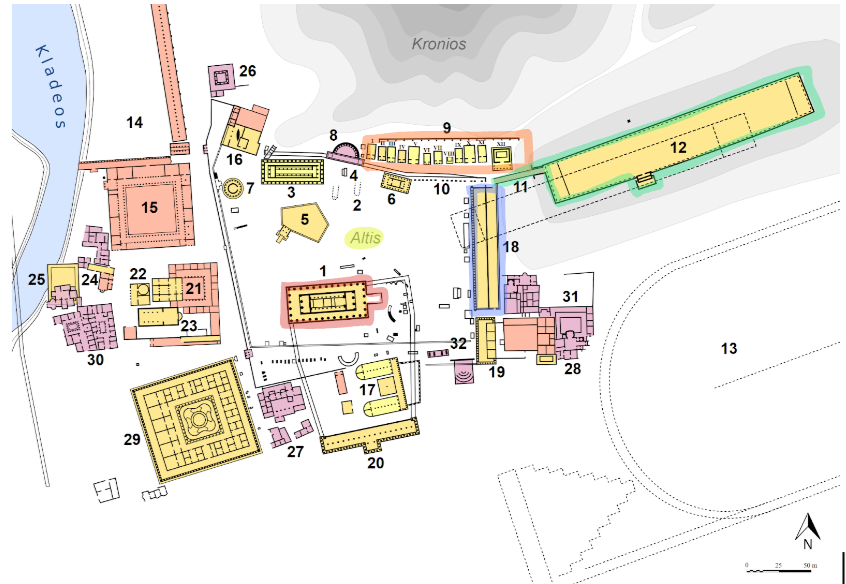
Label the sanctuary at Olympia.
Red = Temple of Zeus
Orange = treasuries
Yellow = ash altar of Olympian Zeus
Green = stadium
Blue = the Echo Stoa
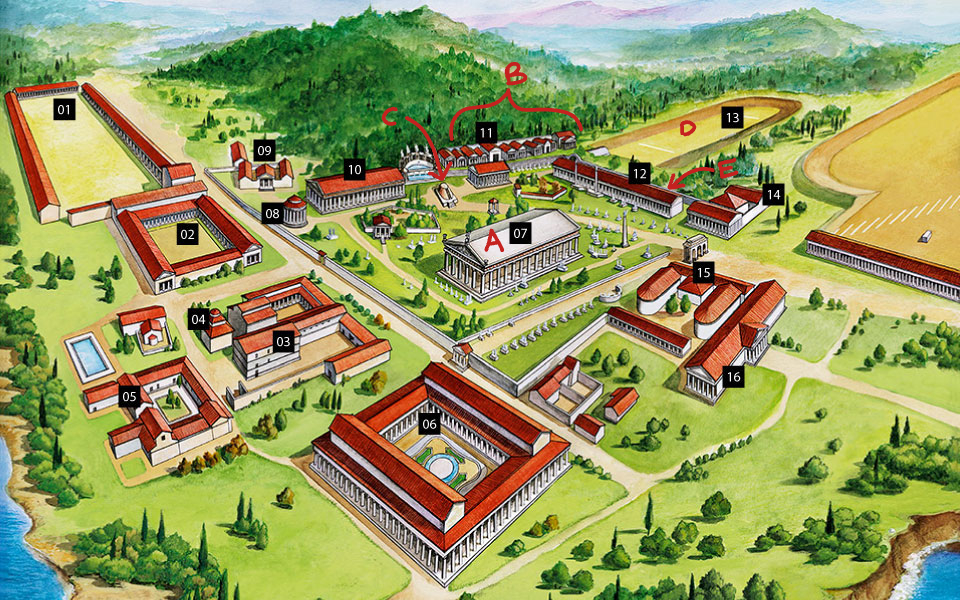
Label the sanctuary at Olympia.
A = Temple of Zeus
B = treasuries
C = ash altar of Olympian Zeus
D = stadium
E = the Echo Stoa
How and why was the new sanctuary at Olympia constructed?
The Eleans conquered Pisa who controlled Olympia, increasing their funds that could be used for the sanctuary.
Building this also fit with the general triumphant mood throughout Greece following the overall defeat of Persia, as poleis worked together to secure mainland Greece.
Olympia had both funding and security, and would need to surpass the sanctuary at Delphi.
Describe the significance of the location and of the Temple of Zeus.
It is the monumental centre of a prestigious shrine
Almost parallel to the temple of Hera, both of which roughly face the rising sun and the ash altar
How big was the temple of Zeus?
27.68 × 64.12 metres (28 × 64)
How did Herodotus get famous? How is this significant?
On the back-porch of the temple of Zeus he did a public reading of his work The Histories — the crowd was so big and lively, he established immediate fame as a Greek writer.
What is the subject matter of the pediments of the Temple of Zeus at Olympia?
East = Chariot race of Pelops and Oinomaos with Zeus presiding
West = Centauromachy with Apollo presiding
What is the subject matter of the metopes of the Temple of Zeus at Olympia?
The twelve labours of Herakles.
What was stored in the cella of the Temple of Zeus at Olympia?
In 432 BCE, 20 years after the temple was completed, a colossal new statue of Zeus was placed in the cella. The upper colonnade was made to carry a viewing gallery, which could be reached by a winding wooden stair inserted either side of the entrance.
Describe the statue of Zeus at Olympia. (5)
12 m high
Crowned with wild olive (like Olympic victors)
Chryselephantine — his flesh was ivory and his robes gold yet ‘wrought with animals and lily-flowers’, however this was a veneer on a core of carved wood
He held a victory (a sizeable statue itself) and a sceptre made of precious metals and topped with Zeus’ eagle
His throne had a gold finish with ebony, ivory, and coloured gems, and adorned with mythical creatures
Describe the plinth of the statue of Zeus at Olympia.
According to Pausanias, it was made from black Eleusinian limestone, and it took up the entire width between two nave colonnades. On it was a scene in gold representing the birth of Aphrodite from the sea, followed by a divine assembly of attendants and framed with the rising chariot of the Sun and the sinking chariot of the Moon.
What was infront of the statue of Zeus at Olympia?
Pheidias had a large shallow pool inserted, made of black limestone and a raised rim of white. It was filled with olive oil, which according to Pausanias aided to counteract the impact of the humid atmosphere’s effect on the statue. Any filtered light would have made the glittering gold and glimmering ivory reflect beautifully on the dark waters.
Describe the location of the ash altar of Zeus at Olympia. (+ source)
According to Pausanias it is “At the same distance from the Pelopeion and the temple of Hera, but further forward than either of them”. It is regarded as the true religious heart of the Altis.
Describe the stature and appearance of the ash altar of Zeus at Olympia. (+ source)
The outer circumference which was marked by stones was 125 feet, and in his time was 22 feet in height. It was cone shaped and circular.
Describe the religious connections of the ash altar of Zeus at Olympia.
The temple of Zeus was built in relation to the altar, facing it at an angle.
It was said to have been started off by Herakles.
Describe the practices in relation to the ash altar of Zeus at Olympia.
At each sacrifice, the part to be burnt for the gods was taken up to the top, and the ashed saved for the 19th day of the Elaphios, when it was mixed with Alphaios’ water, and daubed over the altar, thus increasing it’s size annually. This formed a tangible record of the antiquity of the cult.
Girls and women were only allowed to climb to the first level; only men could go to the top. Hera and Gaea has their own ash altars near their temples.
Translate “Elaphaios”.
The Greek month of Spring equinox.
What is the Altis?
The original name for the sanctuary of Zeus at Olympia.
Describe the location of the treasuries at Olympia.
They are on a raised terrace at the base of the Hill of Kronos, standing together in an uneven line of 11.
Describe the style and characteristics of the treasuries at Olympia.
They were largely Doric in style, and each of them (like those at Delphi) exemplified the characteristics of their own local building styles.
E.g., the largest from Gela in Sicily had a terracotta cladding which was painted with geometric patterns, brought from the homeland in Sicily.
What was the purpose of a stoa?
Stoas provided a shaded and civilised place to meet, as well as to set out stalls and do business.
Why was the Echo Stoa named such?
It was believed that a single word would echo 7 times in it.
How long was the Echo Stoa?
100 metres.
What was the alternative name for the Echo Stoa?
The Stoa Poikile (or Painted Stoa), because of the paintings that once decorated the inside.
What Olympic practice occurred within the Echo Stoa?
The competition of trumpeters and heralds was held here on the first day of the Olympic Games — the winner would be the official trumpeter and herald for the rest of the competition.
Where is the stadium at Olympia located?
Although it started within the sacred area of the Altis, it now stands outside of it.
What is the stadium at Olympia made of, and how big is it?
It was a mainly earth construction (Pausanias) which took advantage of natural contours.
It held 45,000 spectators, was 212.5 metres long, and 28.5 metres wide.
What occurred at the stadium at Olympia? What religious significance does this have?
Running, combat, and field events took place here. Running races always finished facing the Altis, to reflect the religious nature of the event.
What does Pausanias say about the seating arrangement of the stadium at Olympia?
There were stone seats for the presidents of the games on the South side of the stadium
Opposite this was a white stone altar on which the priestess of Demeter sat
He says that virgin girls were not barred from watching, while elsewhere states that all married women except the priestess were barred
What was the Hidden Entrance at Olympia?
A long masonry passage (once a barrel-vaulted tunnel) through which the judges and athletes could make a dramatic appearance.
What stood infront of the treasuries, leading to the Hidden Entrance?
A row of 13 plinths for the Zanes (bronze statues of Zeus), paid for by fines extracted from athletes found cheating.
What was the hippodrome?
A separate course for chariot racing & horse events, added later to the sanctuary of Zeus at Olympia.
Provide 3 examples of religious foundations to the Olympic Games.
The chariot race of King Oinomaos and Pelops.
According to Pausanias, the Cretan Kouretes founded the running race as the brothers raced eachother in the forest, and the winner (Paeonian) was crowned with an olive wreath.
The poet Pindar links the idea that Pisa belongs to Zeus with the idea that Herakles was the founder of the Olympic Games, as depicted on the metopes of the temple.
Give an example of a city-state showing their devotion to Zeus at Olympia.
The 479 BCE statue of Zeus celebrating Greek victory over the Persians. It is inscribed with names of partaking city states.